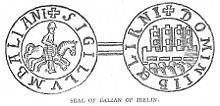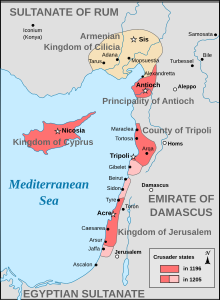Maria Komnene, Queen of Jerusalem
| Maria Komnene | |
|---|---|
Balian, Lord of Ibelin | |
| Issue |
|
Komnenos dynasty | |
| Father | John Doukas Komnenos |
| Mother | Maria Tarontinissa |
Maria Komnene (
Maria was a grandniece of Byzantine Emperor
From 1180, Maria was one of the leaders of the faction opposing Sibylla and her husband
Background
Maria was the daughter of the Byzantine
Maria's cousin
Queenship

Wishing to restore alliance with the powerful Byzantine Empire,
Maria and her household represented Byzantine interests in the
Dowager

Maria's husband, Amalric, came down with dysentery in June 1174.[17] On his deathbed, he granted the city of Nablus, formerly held by his mother, to Maria to be held in fief as dower.[14] He died on 11 July.[17] Maria may have taken part in the ensuing discussion about succession to the throne.[18] Having no other son, Amalric was succeeded by 13-year-old Baldwin, who had not yet been formally diagnosed with leprosy.[19] Despite ominous symptoms, he was seen as a better candidate than his slightly older sister, Sibylla, because she was a girl and unmarried. The claim of Maria's daughter, Isabella, was unviable because she was only two years old.[20]
Diplomatic role
Maria found herself in an unusual situation after Amalric's death; she was the
After reaching the
Count
Ibelin alliance

In late 1177, Queen Maria married
Maria's brother-in-law Baldwin of Ibelin was captured by Saladin in 1179. It is probably she who informed her granduncle Manuel about the scheme to have Baldwin marry Sibylla, prompting the Byzantine emperor to pay his extortionate ransom.
Muslim threat

Isabella and Humphrey's wedding was held at Kerak in late 1183. Maria attended despite being a personal enemy of the groom's stepfather, Raynald. Extravagant festivities were cut short by news of the approach of the Muslim army under Saladin.
In 1184, Saladin again besieged Kerak and once more fled before Baldwin IV's army.[44] Knowing that all the king's troops were at Kerak, he attacked Nablus between 8 and 10 September. As Balian was at Kerak too, it was presumably Maria who conducted the defence. The city was unwalled and she could do nothing to prevent Saladin from sacking it, but no Franks were killed because she took the entire population inside the citadel.[45]
Succession dispute

Completely disabled due to leprosy, Baldwin IV lay on his deathbed in early 1185. He arranged for Sibylla's son, Baldwin V, to undergo a crown-wearing ceremony after which Maria's husband, Balian, expressed their family's support for the boy by carrying him to banquet on his shoulders.
Baldwin V died in mid-1186. Sibylla hurried to Jerusalem to claim the throne. She and her supporters secured most of the
Third Crusade
Saladin took advantage of the discord between the nobles. He invaded the kingdom in April 1187

Unity appeared to have been restored during the crusade until Sibylla and her daughters died of an epidemic in mid-1190.
Last years
The Third Crusade brought the reconquest of a strip of coast from Jaffa to Tyre in 1192,[65] but the kingdom remained without Jerusalem itself.[66] Balian died in 1194 and Maria did not remarry again. She retained an active role in family affairs.[34] Isabella I married twice more and died in 1205.[65] Maria's native Byzantine state, which had ceased to be a great power in the 1180s, was all but destroyed in the Fourth Crusade, while the Kingdom of Jerusalem was reduced to a rump state centred in Acre; yet, Maria's influence only increased.[9]
In 1208 Maria arranged the marriage of Isabella I's daughter Alice of Champagne to King Hugh I of Cyprus. Having outlived all the principal figures of Christian-ruled Jerusalem, Maria may have provided valuable recollections of the kingdom's laws and customs to her son John. She died in mid-1217, in the reign of her great-granddaughter Isabella II. All the kings of Jerusalem and Cyprus and much of the 13th-century nobility of both Cyprus and the mainland kingdom descended from her.[34]
Character
A very hostile source, the Itinerarium Regis Ricardi, describes Maria as being "steeped in Greek filth from the cradle",[67] and says that the character of her husband Balian "matched her own":
Where he was savage, she was godless; where he was shallow-minded, she was fickle; where he was treacherous, she was scheming.[35]
Maria was resilient and adaptable, which enabled her to thrive politically in spite of unfavourable circumstances. Like her mother-in-law Melisende and rival Agnes, Maria desired power, but Hamilton notes that she differed from them in being interested more in practical matters than in appearances and thus worked to acquire power in "more devious" ways.[9] Her opponents described her as ruthless and scheming, and Hamilton concludes that "there was some truth" in their view.[34]
References
- ^ a b c Hamilton 1978, p. 161.
- ^ Hamilton 2005, p. 50.
- ^ Hamilton 2005, p. 31.
- ^ Hamilton 2005, p. 49.
- ^ Hamilton 2005, p. 54.
- ^ Hamilton 1978, pp. 159, 161.
- ^ Hamilton 1978, p. 159.
- ^ Hamilton 2005, p. 26.
- ^ a b c Hamilton 1978, p. 174.
- ^ Runciman 1952, p. 370.
- ^ Hamilton 2005, p. 36.
- ^ Runciman 1952, p. 377.
- ^ a b Hamilton 2005, p. 113.
- ^ a b c d e f Hamilton 1978, p. 163.
- ^ Runciman 1952, p. 404, 443.
- ^ Hamilton 2005, p. 27.
- ^ a b Hamilton 2005, p. 32.
- ^ Hamilton 2005, p. 35.
- ^ Hamilton 2005, p. 38.
- ^ Hamilton 2005, p. 40.
- ^ Hamilton 2005, p. 84.
- ^ Hamilton 2005, p. 95.
- ^ Hamilton 2005, p. 100.
- ^ a b Hodgson 2007, p. 78.
- ^ Hamilton 2005, p. 111.
- ^ Hamilton 2005, p. 106.
- ^ Runciman 1952, p. 414.
- ^ Hamilton 2005, p. 121.
- ^ Hamilton 2005, pp. 127–128.
- ^ Hamilton 2005, p. 129.
- ^ Hamilton 2005, pp. 129–130.
- ^ Hamilton 2005, p. 139.
- ^ Runciman 1952, p. 404.
- ^ a b c d e Hamilton 1978, p. 173.
- ^ a b Hamilton 1978, p. 165.
- ^ Hamilton 1978, p. 166.
- ^ Hamilton 2005, p. 158.
- ^ Hamilton 2005, p. 161.
- ^ Runciman 1952, p. 440.
- ^ Hamilton 2005, p. 192.
- ^ Hamilton 2005, pp. 192–193.
- ^ Hamilton 2005, p. 194.
- ^ Hamilton 2005, p. 196.
- ^ Hamilton 2005, p. 202.
- ^ Hamilton 2005, p. 203.
- ^ Hamilton 2005, pp. 208–209.
- ^ Hamilton 2005, pp. 206–207.
- ^ Hamilton 2005, p. 220.
- ^ Hamilton 2005, pp. 217–218.
- ^ Hamilton 2005, p. 221.
- ^ Riley-Smith 1973, p. 108.
- ^ Runciman 1952, p. 448.
- ^ Hamilton 2005, p. 222.
- ^ Hamilton 2005, p. 227.
- ^ Hamilton 2005, p. 230.
- ^ Hamilton 2005, p. 231.
- ^ Hamilton 2005, p. 172.
- ^ Runciman 1952, p. 463.
- ^ Runciman 1952, p. 465.
- ^ a b c d e Hamilton 1978, p. 172.
- ^ a b Riley-Smith 1973, p. 114.
- ^ Riley-Smith 1973, p. 115.
- ^ Hodgson 2007, p. 188.
- ^ Runciman 1954, pp. 22, 35.
- ^ a b Hamilton 2005, p. 232.
- ^ Hamilton 2005, p. 234.
- ^ Hodgson 2007, p. 189.
Bibliography
- Hamilton, Bernard (1978). "Women in the Crusader States: The Queens of Jerusalem". In Baker, Derek (ed.). Medieval Women. Ecclesiastical History Society. ISBN 978-0631192602.
- Hamilton, Bernard (2005). The Leper King and His Heirs: Baldwin IV and the Crusader Kingdom of Jerusalem. Cambridge University Press. ISBN 9780521017473.
- Hodgson, Natasha R. (2007). Women, Crusading and the Holy Land in Historical Narrative. Boydell Press. ISBN 978-1843833321.
- Riley-Smith, Jonathan (1973). The feudal nobility and the kingdom of Jerusalem, 1147 - 1277. Macmillan.
- ISBN 0241298768.
- ISBN 0-521-06163-6.
